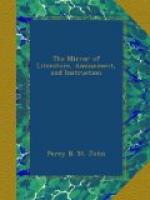There is, near the hall, an ancient refectory, or dining-room, shut up, and in so dangerous a state as to require to be filled with props to support its ceiling. The grand staircase, which is of oak, and coeval with the building, leads to the gallery, in which are situated the principal sleeping-rooms, distinguished as the green, blue, red chambers, &c., according to the predominant colours of the ancient and faded tapestry with which they are hung; nor would the old manor-house deserve the name of such, was there not in one of these a concealed door behind the arras, and in another, the report at least of a ghost. A narrow door, near the end of the gallery, opens immediately upon an old and narrow staircase, the ascent to that chapel in the very roof of the building, which at the period of the Reformation, was contrived and fitted up for the secret advantage of the Roman Catholic proprietors of Sawston; this chamber, for it is nothing more, is certainly little calculated to impress the mind of the spectator with an idea of the splendour of Catholic worship; we approached it by a narrow decaying staircase, stepped over bare rafters, and were scarcely able to pilot ourselves securely by the faint glimmerings of day-light, streaming through the chinks in the tiling overhead. Upon the opening of the chapel door, however, a full tide of light greeted us, admitted by a dormer window, and this displayed an apartment, known by its altar and benches to be appropriated to sacred purposes, the sole decorations of whose plain white-washed walls were some few engravings of madonnas, saints, and holy families, &c., chiefly French, and not particularly beautiful or valuable.
On returning from the chapel we were shown an ingenious hiding-place for the priest in troublous times: a cell covered by a trap-door in the staircase, and just large enough to contain one person, a small table, and a stool; whilst a loop-hole in the wall admitted an apology for light and air. Of heir-looms, there are at Sawston Hall, plenty of curious old pictures and engravings, books, missals, a real relic of chivalry, (light, well-poised, and made of the true lance-wood,) a tilting lance; Queen Mary’s bed, and her pincushion; and a singular glass water-jug, made in the reign of Queen Anne, which, when the present proprietor of Sawston took possession of his inheritance, had been laid up for seventy years; it is now, we believe, off the superannuated list, and sees daily service. We have only space briefly to allude to the tradition, which, sketched at length in the valuable periodical to which we have referred our readers, induced us to supply the present illustrative account. The Princess Mary fleeing from the persecutions of the heads of the Protestant party, was entertained and lodged for a night by Sir John Huddleston, of Sawston. The hall was in consequence besieged by an immense mob from Cambridge, fired, and nearly destroyed; Mary and her host with difficulty escaped, (she disguised as a market-woman,) and as queen, she rebuilt Sawston with the stones of Cambridge Castle.




